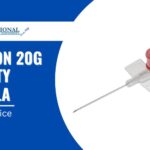Introduction
Intravenous (IV) cannulation is a crucial medical procedure that involves inserting an i.v. cannula into a vein to administer fluids, medications, or blood products. Selecting the appropriate site for IV cannulation is vital for patient comfort, successful insertion, and effective treatment. The choice of site depends on various factors, including the patient’s condition, vein accessibility, and the duration of therapy. This blog explores the best sites for IV cannulation and provides essential tips for successful insertion.
Best Place to Insert an IV Cannula
1. Forearm
The forearm is one of the most preferred sites for IV cannulation. It offers several advantages, such as:
- Easy accessibility with visible and palpable veins
- Lower risk of phlebitis compared to hand veins
- Reduced discomfort for the patient
- Suitable for long-term IV therapy
2. Upper Arms
The veins in the upper arm, particularly the cephalic and basilic veins, are commonly used for IV cannulation when forearm veins are not accessible. Benefits include:
- Larger vein diameter for better flow rate
- Reduced movement, minimizing the risk of dislodgement
- Less painful compared to hand veins
3. Hands
Hand veins, such as the dorsal metacarpal veins, are frequently used in emergencies and short-term therapies. While convenient, they come with certain drawbacks:
- Higher risk of phlebitis and infiltration
- Increased discomfort due to nerve endings in the hand
- Prone to movement, which may cause dislodgement
4. Leg
In specific cases where upper limb veins are unavailable, leg veins like the saphenous vein may be used. However, this site is generally avoided due to:
- Higher risk of thrombosis
- Increased chances of infection
- Limited mobility for the patient
5. External Jugular Vein
The external jugular vein is used in critical care or when peripheral veins are inaccessible. This site is advantageous in emergencies because:
- It provides rapid access to the circulatory system
- Suitable for patients with collapsed peripheral veins
- Allows high-volume infusion
However, this site requires expertise and has a higher risk of complications, such as air embolism or arterial puncture.
Tips for I.V. Cannulation
- Choose the most suitable vein based on patient condition and therapy duration.
- Use a tourniquet to enhance vein visibility and palpability.
- Maintain strict aseptic technique to prevent infections.
- Insert the i.v. cannula at a shallow angle (10-30 degrees) for better success.
- Stabilize the vein by stretching the skin before insertion.
- Avoid joints to reduce the risk of catheter displacement.
- Use the smallest gauge necessary to minimize trauma.
- Secure the i.v.cannula properly with transparent dressings.
- Monitor the site regularly for signs of infiltration or infection.
IV Cannula Manufacturer in India – Denex International
Denex International is a leading IV Cannula Manufacturer and IVCatheter Manufacturer in India, recognized for its high-quality, sterile, and reliable medical devices. With state-of-the-art manufacturing facilities and strict adherence to international standards, Denex International ensures that every ivcannula meets the highest safety and performance benchmarks. The company’s extensive product range includes various types of iv cannula designed for different medical applications, ensuring superior patient care and ease of use for healthcare professionals. Their commitment to innovation and quality has positioned them as a trusted name in the industry, making them the preferred choice for medical institutions across India and beyond.






